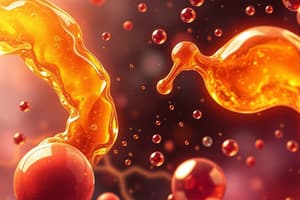Podcast
Questions and Answers
What is the characteristic feature of unsaturated fatty acids?
What is the characteristic feature of unsaturated fatty acids?
- Nonlinear chains with few interactions between chains (correct)
- Solids at room temperature
- Linear chains
- High melting points
What type of fatty acids are essential and cannot be synthesized by the body?
What type of fatty acids are essential and cannot be synthesized by the body?
- Saturated fatty acids
- Polyunsaturated fatty acids (correct)
- Mono-unsaturated fatty acids
- All of the above
What is the function of polyunsaturated fatty acids in the body?
What is the function of polyunsaturated fatty acids in the body?
- Formation of unhealthy cell membranes
- Proper development and functioning of the brain and nervous system (correct)
- Increase in atherosclerosis
- Breakdown of hormone-like substances
Which of the following is NOT a type of polyunsaturated fatty acid?
Which of the following is NOT a type of polyunsaturated fatty acid?
What is the role of polyunsaturated fatty acids in the formation of phospholipids?
What is the role of polyunsaturated fatty acids in the formation of phospholipids?
What is the result of esterification of cholesterol by polyunsaturated fatty acids?
What is the result of esterification of cholesterol by polyunsaturated fatty acids?
What is the function of Eicosanoids produced by polyunsaturated fatty acids?
What is the function of Eicosanoids produced by polyunsaturated fatty acids?
What is the characteristic feature of simple lipids?
What is the characteristic feature of simple lipids?
What is the difference between mono-unsaturated and polyunsaturated fatty acids?
What is the difference between mono-unsaturated and polyunsaturated fatty acids?
Which of the following fatty acids can be synthesized in the body?
Which of the following fatty acids can be synthesized in the body?
Flashcards are hidden until you start studying
Study Notes
Waxes
- Waxes are composed of fatty acids and higher molecular weight monohydric alcohols.
Fats
- Fats are esters of fatty acids with glycerol.
- They are solid at room temperature, but some are liquid at room temperature and are known as oils.
- The physical state of fats depends on the nature of the fatty acids.
- Fats are rich in saturated fatty acids, while oils are rich in unsaturated fatty acids.
- Fatty acids can form mono-, di-, or tri-esters with the alcohol groups of glycerol.
Neutral Fats (Triacylglycerols or Triglycerides)
- Neutral fats are also known as triacylglycerols (TAG) or triglycerides (TG).
- They are esters of the trihydricalcohol, glycerol, with fatty acids.
Compound Lipids
- Compound lipids include:
- Phospholipids
- Glycolipids
- Lipoproteins
Phospholipids
- Phospholipids are lipids conjugated with phosphoric acid.
- Functions of phospholipids:
- Structure component of cell membrane and nervous system
- Formation of surface layer of lipoprotein
- Dipalmityl lecithin acts as a lung surfactant
- Signal transduction of hormones
- There are two classes of phospholipids:
- Glycerophospholipids (phosphoglycerides)
- Sphingolipids
Glycerophospholipids
- Glycerophospholipids are the major lipid components of biological membranes.
- They are derivatives of phosphatidic acid.
- Examples of glycerophospholipids:
- Phosphatidic acid
- Lecithin (phosphatidylcholine)
- Cephalin
- Phosphatidyl serine
- Cardiolipin
Phosphatidic Acid
- Phosphatidic acid is made up of one glycerol molecule to which two fatty acid residues are esterified to carbon atoms 1 and 2.
- The 3rd hydroxyl group is esterified to a phosphoric acid.
- It is the parent of all glycerophospholipids.
Lecithin (Phosphatidylcholine)
- Lecithin is composed of a choline head group and glycerophosphoric acid, with a variety of fatty acids.
- Usually, one fatty acid is saturated and the other is unsaturated.
Lung Surfactants
- Dipalmityl-lecithin: it contains two molecules of palmitic acid and acts as a lung surfactant.
Cephalin
- Cephalin differs from lecithins only in that choline is replaced by ethanolamine or serine.
- Sources: brain tissues
- Enters in the formation of cell walls and thromboplastin.
Phosphatidyl inositol
- Phosphatidyl inositol: phosphatidic acid + inositol.
Cardiolipin
- Cardiolipin: two molecules of phosphatidic acid linked together by one molecule of glycerol.
Sphingophospholipids
- Sphingophospholipids contain amino alcohol sphingosine instead of glycerol.
Glycolipids
- Glycolipids are made up of a fatty acid, an alcohol, and some carbohydrates.
Lipoproteins
- Lipoproteins are made up of some lipids combined with specific proteins.
Unsaturated Fatty Acids
- Unsaturated fatty acids contain one or more double C=C bonds.
- Characteristics:
- Nonlinear chains do not allow molecules to pack closely
- Few interactions between chains
- Low melting points
- Liquids at room temperature
Subclassification of Unsaturated Fatty Acids
- Mono-unsaturated: having a single double bond
- Polyunsaturated: with 2 or more double bonds
Polyunsaturated Fatty Acids
- Polyunsaturated fatty acids are essential fatty acids, which cannot be synthesized by the body and must be supplied in the diet.
- Examples:
- ω3 (omega 3) family - Linolenic acids
- ω6 family - Linoleic and Arachidonic acids
Clinical Significance of Polyunsaturated Fatty Acids
- Formation of healthy cell membranes
- Proper development and functioning of the brain and nervous system
- Enter in the composition of phospholipid (a type of compound lipid)
- Causing esterification of cholesterol (free cholesterol), so decrease atherosclerosis (CHD)
- Production of hormone-like substances called Eicosanoids (important for inflammation reaction and allergic reaction)
Studying That Suits You
Use AI to generate personalized quizzes and flashcards to suit your learning preferences.




